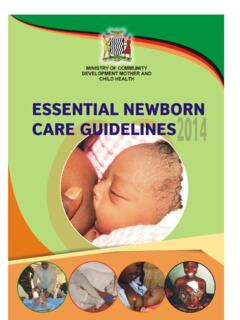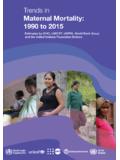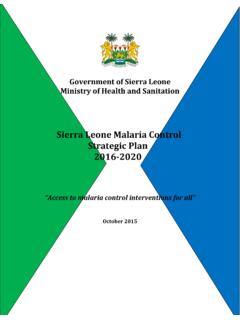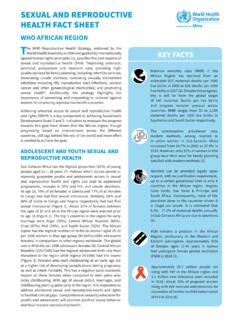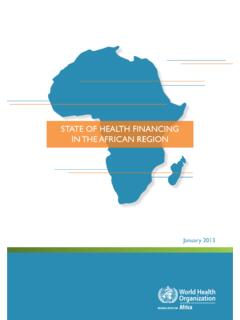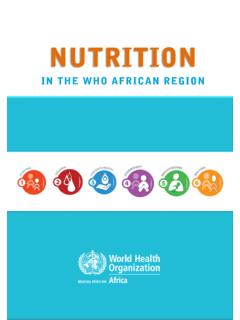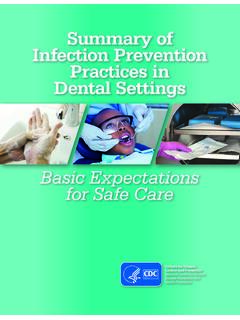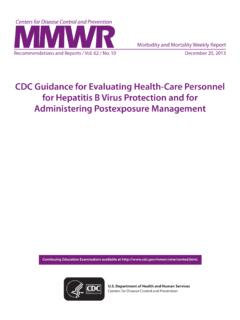Transcription of National Infection Prevention and Control Guidelines
1 National Infection Prevention and Control Guidelines GOVERNMENT OF THE REPUBLIC OF SIERRA LEONEMINISTRY OF HEALTH AND SANITATIONSIERRA LEONEN ationalInfection Preventionand Control GuidelinesTABLE OF CONTENTSF oreword ..Acknowledgements ..List of Contributors and Reviewers ..Abbreviations ..INTRODUCTION ..Background ..Rationale ..Situation Analysis ..Purpose ..Use of these Guidelines ..General Policy Sta tements ..STRUCTURE AND MANAGEMENT OF THE IPC PROGRAMME: IPC POLICY ..Responsibility and Authorit y ..INTRODUCTION TO HAI AND IPC.
2 The Chain of Inf ection ..IPC Principles ..Common and Important HAIs ..STANDARD PRECAUTIONS AND TRANSMISSION BASED PRECAUTIONS .. Standard Precautions General ..Hand Hygiene ..Personal Protective Equipment (PPE) ..Respiratory Hygiene and Cough Etiquette ..Injection and Phlebotomy Saf et y and Sharps Injury Prevention ..Decontamination of Medical Devices, Linen and Laundry and the Environment ..Health Car e Waste Management ..Transmission-based Precautions ..SPECIAL AREAS OF THE HOSPITAL ..Operating Theatr es ..Clinical Laboratory.
3 Antenatal and Labour suite IPC ..Inf ection Prevention Contr ol Standards in the Mortuary Setting ..OCCUPATIONAL SAFETY AND EMPLOYEE HEALTH ..THE IMPORTANCE OF SURVEILLANCE FOR Infection Prevention AND Control ..Surveillance ..Standard precautions in health care ..Ref er ences ..Chapter 6 Chapter III IVV1 1 1 12 22 4 4 6 6 6 7 20 20 21 27 31 31 45 73 92 118 122 122 136 142 144 146 168 168 174 180 IFOREWORDIIIIIACKNOWLEDGEMENTSThe National IPC Guidelines wer e commenced in 2014 under the leadership of the MOHS.
4 From May-July 2015 a team to ensure consistency with available evidence and in ter National standards. The over all process was led by Julie Storr (WHO HQ) and Amy Kolkwaite (CDC Atlanta) under the direction of the National IPC lead for Sierra Leone. Individual chapter reviewers are listed below: Editorial Review Team (WHO IPC Unit):Alaa Gad HashishAnne EastawayBuyiswa Lizzie SitholeHarish MurthiLIST OF CONTRIBUTORS AND REVIEWERSIVCHAPTERSWHOCDCC hapter 1 INTRODUCTION Julie StorrAmy KolwaiteChapter 2 STRUCTURE AND MANAGEMENT OF :EMMARGORP CPI EHTIPC POLICY Julie StorrAmy KolwaiteChapter 3 INTRODUCTION TO HAI AND IPCAlaa Gad HashishPaul MalpiediChapter 4 STANDARD PRECAUTIONS AND TRANSMISSION BASED PRE-CAUTIONS Bassem ZayedBenedetta AllegranziClaire KilpatrickNizam DamaniTerry GrimmondDenise KirleyNeil GuptaNorah CheaChapter 5 SPECIAL AREAS OF LATIPSOH EHTC laire KilpatrickNizam DamaniDenise KirleyKatie WilsonChapter 6 OCCUPATIONAL SAFETY AND EMPLOYEE HEALTH Heidi Rober Ric eTom SutterDenise KirleyKatie WilsonChapter 7 THE IMPORTANCE OF SURVEILLANCE FOR Infection Prevention LORTNOC DNAB assem
5 ZayedClaire KilpatrickJulie StorrNorah CheaABBREVIATIONSVABHRACHACIPADAIIAIIRAN TTARTAZTBBFBSCBSLBSICAPCDCECGETEVDGoSLGM THAIHAPHCFHCWHBsAgHBVHCVHLDHIVIPCIPCCILD IMEESCIPPVIVLLDLTBINGOMERS-CoVMoHSMSDMTB PEPPPEPQSRNARUPUNSARSSISIPSOPSSITdapTLVT BUTIVAPWHOWMSDWPVXDR TB Alcohol based handrubAir changes per hourAdvisory Committee on Immunization PracticesAutodisableAirborne Infection isolationAirborne Infection isolation roomAseptic non-touch techniqueAnti retroviral treatmentAzidothymidine (zidovudine)Blood and body fluidsBiosafety cabinetBiosafety LevelBlood stream infectionCommunity acquired pneumoniaUnited States Centers for Disease Control and PreventionElectrocardiogramEndotracheal tubeEbola virus diseaseGovernment of Sierra LeoneGood Microbiological TechniqueHealth care associated infectionHealth care acquired pneumoniaHealthcare facilityHealth care workerHepatitis B surface antigenHepatitis B virusHepatitis C virusHigh level disinfectionHuman immune deficiency virusInfection Prevention and controlInfection Prevention and Control committeeIntermediate level
6 DisinfectionIntegrated Management for Emergency and Essential Surgical CareIntermittent positive pressure ventilationIntravenousLow level disinfectionLatent TB infectionNon government organizationsMiddle East Respiratory Syndrome coronavirusMinistry of Health and SanitationMusculoskeletal diseaseMycobacterium TuberculosisPost exposure prophylaxisPersonal Protective EquipmentPerformance quality and safetyRibonucleic acidReuse protectionUnited NationsSevere Acute Respiratory SyndromeSharps injurySharps injury protectionStandard Operating ProcedureSurgical site infectiontetanus, diphtheria and pertussisThreshold limit valueTuberculosisUrinary tract infectionVentilator associated pneumoniaWorld Health OrganizationWorkplace musculoskeletal diseaseWorkplace violenceExtensively drug resistant TB1 Chapter BackgroundInfection Prevention and Control (IPC) is universally acknowledged as a vital component of a comprehensive ap-proach to patient and healthcare worker safety, quality improvement, and improved health outcomes.
7 The evolving landscape of emerging infectious diseases necessitates increased awareness and attention to IPC. A strong health system, which includes a culture and infrastructure of IPC, such as improved hygiene conditions, appropriate use and availability of personal protective equipment (PPE), and improved healthcare waste management, will equip govern-ments and communities to respond to and manage outbreaks, and will prevent the spread of infectious diseases including healthcare-associated infections (HAI). The 2014 Ebola virus disease outbreak in West Africa accelerated ef-forts to strengthen health systems in Sierra Leone, including the establishment of a Ministry of Health and Sanitation (MoHS)-led National IPC Unit1.
8 The development of National Guidelines on IPC has been prioritised as one of the first outputs of the National IPC Sierra Leone MoHS have developed a National IPC policy to provide a framework for the development and implementation of Guidelines and standard operating procedures (SOPs) in order to establish a culture of safety in healthcare facilities. With technical support from WHO and CDC, the MoHS has developed National IPC Guidelines to provide comprehensive and standardised recommendations for an improved IPC culture and infrastructure in Sierra RationaleIPC is concerned with patient and healthcare worker safety and is part of a multidisciplinary approach to strengthen-ing the healthcare system.
9 HAIs, also termed nosocomial infections, are infections occurring in a patient during the process of care in a hospital or other healthcare facility, which was not present at the time of admission, typically more than 48 hours after admission. This includes infections acquired in the healthcare system that appear after discharge, and occupational infections among facility staff. Due to limitations in surveillance and subsequent lack of data, the disease burden and economic impact of HAIs in developing countries are not well understood. However, available data suggests a disproportionate burden of HAI in Africa compared with many other parts of the world - newborns are at highest risk, with HAI responsible for 75% of all neonatal deaths2.
10 Previously, HAIs in Sierra Leone have not been systematically tracked or studied. However, there is a consensus, in-formed by the 2014 Ebola outbreak that HAIs are a very real threat to patient and healthcare worker safety and need to be the subject of surveillance and investigation. In Sierra Leone, a comprehensive IPC system with National evi-dence-based IPC Guidelines and strategies is critical to ensure IPC practices and procedures are implemented and adhered to with the aim of reducing HAIs, achieving best health outcomes, and preventing future Situation AnalysisMultiple assessments conducted by the MoHS and partner organizations World Health Organization [WHO], Cent-ers for Disease Control and Prevention [CDC]
